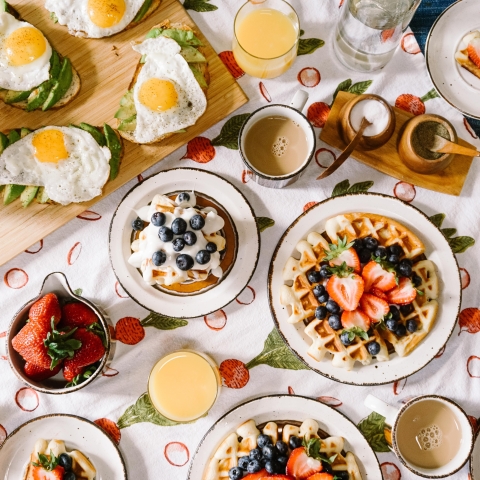How to Maintain Good Dietary Habits While Traveling for Business

It’s late; you’ve skipped dinner, again; and the hotel mini bar beckons. What will it be: overpriced potato chips, M&Ms, or maybe both? With a little advance planning, you could have prevented the strike of nighttime hunger — and perhaps a multitude of health issues down the road.
While more research is needed on humans to determine whether calories eaten are night are more likely to cause weight gain than the same number of calories consumed during the day (as one study conducted on mice by Northwestern University suggested), there’s no question that making poor eating choices at night — or any time of day — over time makes you feel less than optimal.
Combined with hectic event schedules, lots of dining out and alcohol around every turn, event professionals can have the odds stacked against them when it comes to eating healthfully on the road.
We spoke with a few experts to get their tips and tricks for practicing better nutrition during each part of traveling for business. The best part? They’re relatively easy to implement, and may just become part of your routine once you’ve learned which ones work best for you.
En Route to Your Destination
Pack smart snacks.
Preparation is the No. 1 way to ensure healthy eating while traveling.
“Remember that you’re in control of your choices. Every food or drink choice is a decision,” says Samantha Presicci, registered dietician at Snap Kitchen, a company that sells fresh-made, healthy prepared meals. “Set yourself up for success by planning ahead and envisioning how you’d like to feel during and after your trip.”
She recommends packing in-flight snacks like clean-ingredient jerky, raw nuts and seeds, fruit, full-fat cheese, olives and good-quality dark chocolate, prioritizing proteins and healthy fats to keep you full.
Do your research during downtime.
Instead of mindlessly clicking around Instagram, take time to look into healthy eating options in your destination while you’re waiting for your flight.
“Find restaurants around where you are staying that offer food that fits your diets and interests,” says chef Michael Sabrin, who also works with Snap Kitchen.
Try a juice bar.
Travel can be taxing to your body and immune system, adding more stress and exposure to germs than your regular routine. To combat this, give your system some extra oomph by sipping a green, dark red or purple juice from an airport juicery.
“These are a great way to get a vitamin or mineral boost that otherwise would be hard to find while traveling,” says Sabrin (just watch out for added sugars).
In Your Hotel Room
Make the most of your mini bar — in an unexpected way.
Here’s a clever way to use your hotel fridge for healthy choices — and avoid going broke on the junk food typically stored here.
“Call the hotel in advance and see if they will clear the mini fridge for you,” suggests Rachel Daniels, senior director of nutrition at Virtual Health Partners.
She adds, “If they are willing to, you can make a pit stop at a nearby grocery or convenience store to pick up some easy items: Think yogurt, fresh sliced turkey, mini hummus cups, hard-boiled eggs, sliced or steamable vegetables, and fruit.”
Stock up on nonperishables.
Shelf stable items like tuna packets, oatmeal, nut butters, whole-grain crackers, avocado, tomatoes, apples, oranges, bananas and sweet potatoes (which can be microwaved) all make great choices, says Daniels. You can also try updated versions of typical microwave meals.
“A few brands make shelf-stable quinoa, lentil or rice bowls that are great for travel,” she says. “A bowl of quinoa with some chickpeas and steamed green beans is a filling meal; or crackers with tuna, avocado and sliced vegetables is an easy lunch.”
Stay hydrated.
“It sounds funny, but on days when it is hard to get in enough hydration, I will drink a children’s-formulated electrolyte drink like Pedialyte to rehydrate for the next day,” says Sabrin. “It will make a difference.”
Traveling with a reusable water bottle (this one with a built-in filter, though expensive, instantly removes any contaminants) is another smart idea — and better for the environment than consuming lots of plastic bottles.
Dining Out With Clients
Limit your alcohol consumption.
Try to stick to one or two drinks, preferably an alcoholic beverage without added sugars — like a glass of dry wine or vodka with soda and lime, says Daniels. Sip slowly to make it last, and remember to drink lots of water before, during and after your meal to help you stay hydrated and avoid overeating.
Everyone else getting another drink with dessert? You don’t have to miss out.
“Get a seltzer with ice and a few wedges of citrus fruit, or a cup of decaf tea,” Daniels advises.
Order wisely.
Choose a protein and veggie main dish — think salmon with greens, or a lean meat with asparagus.
“This leaves room for any extras that may be part of the meal, like some bread or a fun dessert,” says Daniels.
When you can, take part in picking a restaurant that you know has healthy and tasty options to accommodate the whole group (this is where your advance research comes in).
Eat mindfully.
When your food arrives, take time to savor each bite, and notice the flavors and textures of your meal. Then, don't finish it—shoot for ¾ or even half of the meal, says Sabrin.
“There is a measure of self-control that is difficult in this,” he says, “but you will feel better the next day if you do not overeat.”


Add new comment